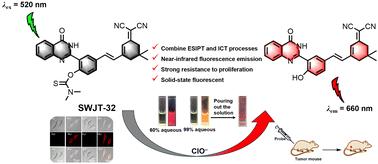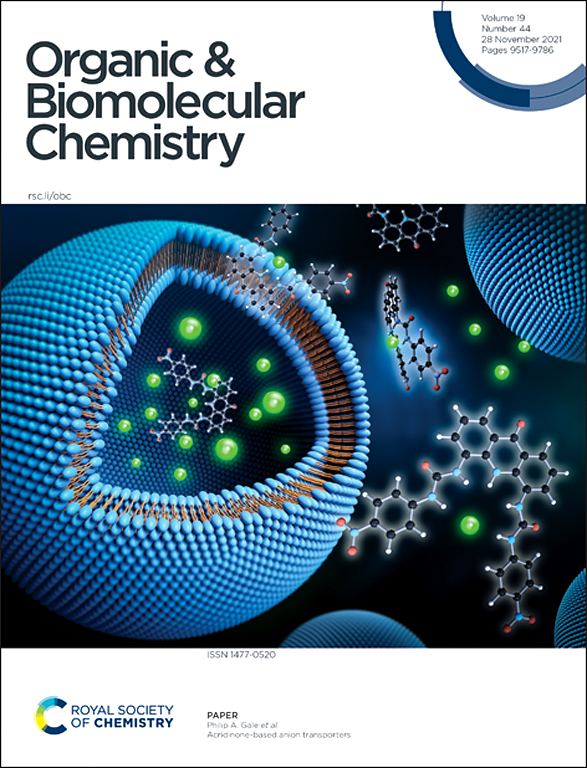一种基于hpq的近红外染料,用于ClO-的检测和细胞和小鼠肿瘤部位的原位准确成像。
IF 2.7
3区 化学
Q1 CHEMISTRY, ORGANIC
引用次数: 0
摘要
以2-(2-羟基苯基)-4(1H)-喹唑啉酮(HPQ)为骨架,N,N-二甲基硫代氨基甲酸酯为识别位点,设计并合成了具有大Stokes位移的新型荧光探针SWJT-32。利用激发态分子内质子转移(ESIPT)和分子内电荷转移(ICT)机理,通过荧光光谱检测次氯酸盐离子(ClO-)。该探针具有抗扩散能力强、光稳定性和选择性好、成像对比度高等优点,可用于ClO-的检测。同时,由于SWJT-32毒性低,在活细胞中具有良好的生物相容性,可用于HeLa细胞内源性和外源性ClO-的检测,也可用于肿瘤小鼠的长期体内成像。本文章由计算机程序翻译,如有差异,请以英文原文为准。

An HPQ-based near-infrared dye for the detection of ClO− and accurate imaging of cells and mouse tumor sites in situ†
A new fluorescent probe () with a large Stokes shift was designed and synthesized with 2-(2-hydroxyphenyl)-4(1H)-quinazolinone (HPQ) as the skeleton and N,N-dimethylthiocarbamate as the recognition site. It can detect hypochlorite ions (ClO−) through fluorescence spectroscopy based on the excited-state intramolecular proton transfer (ESIPT) and intramolecular charge transfer (ICT) mechanism. The probe has the advantages of strong diffusion resistance, good photostability and selectivity, and high imaging contrast, and can be used for the detection of ClO−. Meanwhile, due to its low toxicity and good biocompatibility in living cells, can be used for the detection of endogenous and exogenous ClO− in HeLa cells as well as for long-term in vivo imaging in tumor mice.
求助全文
通过发布文献求助,成功后即可免费获取论文全文。
去求助
来源期刊

Organic & Biomolecular Chemistry
化学-有机化学
CiteScore
5.50
自引率
9.40%
发文量
1056
审稿时长
1.3 months
期刊介绍:
Organic & Biomolecular Chemistry is an international journal using integrated research in chemistry-organic chemistry. Founded in 2003 by the Royal Society of Chemistry, the journal is published in Semimonthly issues and has been indexed by SCIE, a leading international database. The journal focuses on the key research and cutting-edge progress in the field of chemistry-organic chemistry, publishes and reports the research results in this field in a timely manner, and is committed to becoming a window and platform for rapid academic exchanges among peers in this field. The journal's impact factor in 2023 is 2.9, and its CiteScore is 5.5.
 求助内容:
求助内容: 应助结果提醒方式:
应助结果提醒方式:


